You are seeing an unstyled version of this site. If this is because you are using an older web browser, we recommend that you upgrade to a modern, standards-compliant browser such as FireFox [http://www.getfirefox.com/], which is available free of charge for Windows, Mac and Linux.
Neo-Assyrian Archival Texts from Sam'al
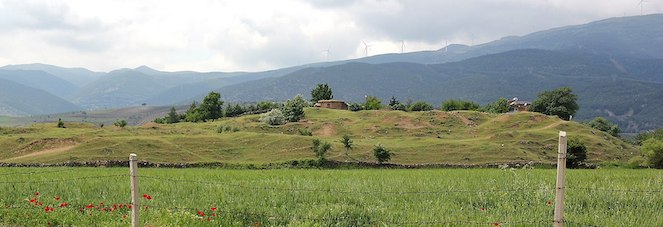
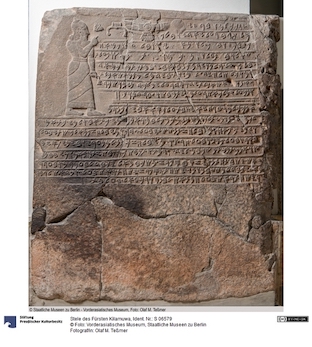
The stele of Kilamuwa, king of Bit-Gabbari. Vorderasiatisches Museum Berlin,VA S 6579. Image Credit: Vorderasiatisches Museum [https://smb.museum-digital.de/index.php?t=objekt&oges=141488], Staatliche Museen zu Berlin / Olaf M. Teßmer.
The archaeological site of Zincirli Höyük [https://zincirli.uchicago.edu] in south-eastern Turkey corresponds to the ancient city of Sam'al. In the early first millennium BC, it was the center of the kingdom of Bit-Gabbari ("House of Gabbaru"; after the founding father of the original ruling house). This small state benefitted from its key position on an important overland connection that linked up the Syrian plains with the mountain lands of Inner Anatolia. When Tiglath-pileser III [/rinap/rinap1/] of Assyria (744–727 BC) expanded the imperial territories as far as the nearby Mediterranean coast, the kingdom of Unqu in the Amuq plain of the Orontes river was annexed and the Assyrian province of Kullania was established in 738 BC. However, the northern neighbor Bit-Gabbari was left intact, and a famous monument of its eighth-century king Kilamuwa explains why: Not only had he himself depicted in Assyrian dress, he proudly stressed in the accompanying Phoenician inscription his close relationship with the Assyrian king whose forces he used against his regional rival, the ruler of nearby Que (Cilicia).
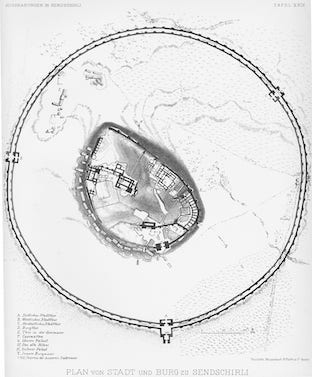
Robert Koldewey's 1894 plan of Sam'al (modern Zincirli Höyük). Reproduced from Felix von Luschan, Ausgrabungen in Sendschirli [https://zincirli.uchicago.edu/previous-excavations/], Berlin 1983, pl. 29.
When the kingdom of Bit-Gabbari now bordered in its south directly on the holdings of the Assyrian Empire, the even closer client relationship initially greatly benefitted Bit-Gabbari, whose ruler Panamuwa II rebuilt the royal palace on the settlement mound and gave the lower city its fortification wall with the characteristic circular shape. Although a descendant of the royal house, Panamuwa owed his throne to Tiglath-pileser III who had supported him during a dynastic conflict that threatened his and his immediate family's survival, as a memorial inscription issued on his behalf by his son and successor Bar-rakib makes clear. In turn, the Assyrian king lists "Panammû" (so the Assyrian spelling of his name) among his loyal client rulers in his own inscriptions (e.g., in the Iran Stele [/rinap/Q003448/] iii 17), and according to Bar-rakib, he substantially enlarged Bit-Gabbari's territory at the expense of the neighboring states Que and Gurgum, which were on far less favourable terms with the empire.
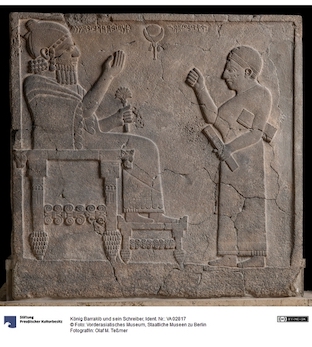
Stone relief of Bar-Rakib, the last king of Bit-Gabbari, seated on his throne and attended by his scribe who carries a wooden writing tablet and a box with his writing utensils. Vorderasiatisches Museum Berlin, VA 2817. Image Credit: Vorderasiatisches Museum [https://smb.museum-digital.de/singleimage.php?resourcenr=164545], Staatliche Museen zu Berlin / Olaf M. Teßmer.
At least at first, Bar-rakib seems to have been just as faithful a servant to his Assyrian overlord as his father. However, at some point during the short reign of Tiglath-pileser's successor Shalmaneser V [/rinap/rinap1/] (726–722 BC), Bit-Gabbari was integrated into the Assyrian Empire, just like its western neighbor and traditional rival Que. As no royal inscriptions and very few other sources are available for the reign of Shalmaneser V, it is impossible to pinpoint the exact year in which these events unfolded, or perhaps more importantly, why. Interestingly, the results of the recent, large-scale excavations indicate a remarkable continuity in the settlement during that time, despite the political upheaval that one is tempted to associate with a country's loss of independence. In any case, the erstwhile kingdom of Bit-Gabbari was now turned into the Assyrian province of Sam'al, and the city became the seat of an Assyrian governor. The earliest attestations for the Assyrian province are found in administrative texts dating to the reign of Sargon II [https://www.ucl.ac.uk/sargon/essentials/kings/sargonii//atae/P335781,P335774,P336205,P224658] (721–705 BC; SAA 7 116 [/atae/P335781]:11'; SAA 7 136 [/atae/P335774] rev. i 10'; SAA 11 6 [/atae/P336205]:2'; CTN 3 86 [/atae/P224658]:13).
The site of Zincirli Höyük [https://zincirli.uchicago.edu/] was first excavated in five campaigns between 1888 and 1902 led by Carl Humann, Felix von Luschan and Robert Koldewey and funded by the Deutsche Orient-Gesellschaft and the Rudolf-Virchow-Stiftung in Berlin. More than a century later, a team of the Oriental Institute of the University of Chicago headed by David Schloen began further excavations at the site in 2006, since 2014 in cooperation with the University of Tübingen. While these works have brought to light an impressive number of inscribed stone monuments in alphabetic script from the time of the kingdom of Bit-Gabbari, the textual sources retrieved from the period of the Assyrian occupation are surprisingly meagre.
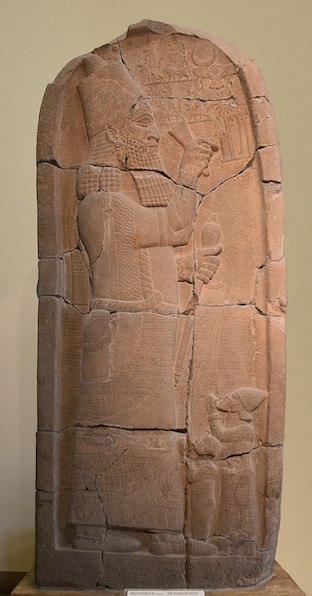
The so-called Zinjirli Stele of Esarhaddon of Assyria (680–669 BC). Vorderasiatisches Museum Berlin, VA 2708. Image Credit: Richard Mortel [https://www.flickr.com/people/43714545@N06]. This file is licensed under the Creative Commons Attribution 2.0 Generic license [https://creativecommons.org/licenses/by/2.0/deed.en].
The most important piece is the victory stele [/rinap/Q003327/] that Esarhaddon [/rinap/rinap4/] of Assyria (680–669 BC) had erected at Sam'al in the year 670. Cut carefully into several pieces, it was found inside the so-called Citadel Gate leading to the inner city with the palace on the ancient settlement mound. In text and image, this monument celebrates Esarhaddon's recent victories over his reluctant Phoenician [https://www.ucl.ac.uk/sargon/essentials/countries/tabalandphrygia/] client Abdi-Milkuti, king of Sidon, and the Nubian ruler Taharqa of Kush [https://www.ucl.ac.uk/sargon/essentials/countries/kush/], whose dynasty's claim over Egypt the Assyrian Empire contested, resulting in an invasion of the Nile region in 671 BC. On the stele, the Phoenician king and the Kushite crown prince are depicted as Esarhaddon's prisoners, and the Assyrian ruler looms large over his diminutive kneeling captives, holding them on ropes fed through lip rings — like oxen: this unusual depiction translates into powerful imagery the Assyrian vocabulary of imperial supremacy, which has the client rulers of the Empire "draw the yoke of the god Aššur."
There are only two Neo-Assyrian clay tablets known from Sam'al, and both were found during the early excavations at the site. Long thought lost, they were recently rediscovered in the stone depot of the Vorderasiatisches Museum Berlin and edited by Betina Faist. Both texts are fragmentary sale contracts for slave women. The first tablet [/atae/samal/P522659/] dates to the year 713 BC, during the reign of Sargon II and was therefore written within a decade or so after Sam'al's integration into the Assyrian Empire. Were the tablet's origin from that city not beyond any doubt, one would be tempted to assume that it comes from Harran, the city of the moon-god Sîn (Aramaic Sehr), which is located 200 km to the east near modern Şanlıurfa. The buyer is called Sîn-belu-uṣur ("O Sîn, protect the lord!," an Assyrian name); the slave woman's name Nikkal-sūrī ("The goddess Nikkal is my fortress," an Aramaic name) evokes the moon-god's spouse Nikkal; and the first witness is identified as a craftsman of Nusku, the god of light and the son of Sîn and Nikkal. At Harran stood the principal shrine of these three deities, a hugely important temple that also received much attention and support from the kings of Assyria.
The second tablet [/atae/samal/P522658/] is substantially later and dates to the year 671 BC, in the reign of Esarhaddon. Because we lack context, it is difficult to say whether we should attribute much significance to that date, but it is noteworthy that the small archive from Burmaria [/atae/burmarina/] stops at about that same time. Just like in that case, should we perhaps assume that the document from Sam'al bears witness to a family archive that came to an end in connection with Esarhaddon's suppression of the 671/670 rebellion [/saao/knpp/essentials/esarhaddon/index.html] against his rule? Such an assumption would broadly match the results of the recent excavations, which provided several indications that the city suffered a major disruption and was at least partially abandoned during the first half of the seventh century BC. That Esarhaddon erected his victory stele with its evocative imagery specifically in Sam'al may have been designed to remind his local subjects of his power and what it meant to serve the empire. That his dynasty was stable and would outlast any resistance was prominently signaled by the depictions of Esarhaddon's heirs-apparent, Ashurbanipal as crown prince of Assyria and Samaš-šumu-ukin as crown prince of Babylon, on the left and right sides of the stele. One would very much like to know when precisely Esarhaddon's stele was carved in an act of very deliberate destruction into the pieces in which it was eventually found. Did this happen during the years of war from 614 BC onwards when the Assyrian Empire disintegrated, or already at an early time?
Click here [/atae/samal/pager] to browse the Sam'al corpus.
The aim of the Sam'al sub-project of ATAE is to make the published Neo-Assyrian archival texts from Zinçirli available online for free in a fully searchable and richly annotated (lemmatized) format, as well as to widely disseminate, facilitate, and promote the active use of these important cuneiform sources in academia and beyond. ATAE/Sam'al presently includes Neo-Assyrian sources edited and discussed in the following publication:
- Betina Faist, "Die Keilschrifttafeln aus Samʾal (Zincirli)," State Archives of Assyria Bulletin 20 (2013–14): 33–46.
For translations of ancient inscriptions refering to Sam'al or its rulers, see the section "Inscriptions [https://zincirli.uchicago.edu/inscriptions/]" on the Chicago-Tübingen Expedition to Zincirli [https://zincirli.uchicago.edu/site-and-setting/] website, which offers a wealth of information on the archaeological site and its exploration.
ATAE is a key component of the Archival Texts of the Middle East in Antiquity (ATMEA) sub-project of the LMU-Munich-based Munich Open-access Cuneiform Corpus Initiative [https://www.en.ag.geschichte.uni-muenchen.de/research/mocci/index.html] (MOCCI; directed by Karen Radner and Jamie Novotny). Funding for the ATAE corpus project has been provided by LMU Munich and the Alexander von Humboldt Foundation (through the establishment of the Alexander von Humboldt Chair for Ancient History of the Near and Middle East).
For further details, see the "About the project" [/atae/abouttheproject/index.html] page.

Home Page banner credit
View of the ruins of Sam'al (modern Zinçirli). Photo credit: Klaus-Peter Simon [https://commons.wikimedia.org/wiki/File:Zincirli1.jpg]. This image is licensed under the Creative Commons Attribution-Share Alike 3.0 Unported license [https://creativecommons.org/licenses/by-sa/3.0/deed.en].
Karen Radner
Karen Radner, 'Neo-Assyrian Archival Texts from Sam'al', Neo-Assyrian Archival Texts from Sam'al, The ATAE/Sam'al Project, a sub-project of MOCCI, 2023 [http://oracc.org/samal/]